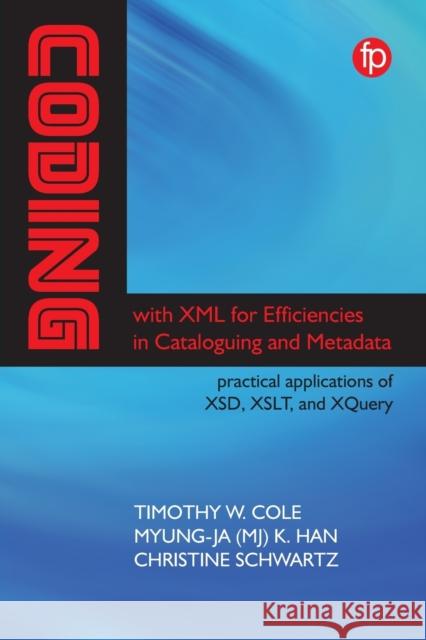Coding with XML for Efficiencies in Cataloging: Practical applications of XSD, XSLT, and XQuery » książka
Coding with XML for Efficiencies in Cataloging: Practical applications of XSD, XSLT, and XQuery
ISBN-13: 9781783303694 / Angielski / Miękka / 2018 / 176 str.
Coding with XML for Efficiencies in Cataloging: Practical applications of XSD, XSLT, and XQuery
ISBN-13: 9781783303694 / Angielski / Miękka / 2018 / 176 str.
(netto: 255,27 VAT: 5%)
Najniższa cena z 30 dni: 265,29
ok. 30 dni roboczych
Dostawa w 2026 r.
Darmowa dostawa!
This practical guide will be essential reading for all those needing to come up to speed quickly on XML and how it is used by libraries today. XML and its ancillary technologies XSD, XSLT and XQuery enables librarians to take advantage of powerful, XML-aware applications, facilitates the interoperability and sharing of XML metadata, and makes it possible to realize the full promise of XML to support more powerful and more efficient library cataloguing and metadata workflows. While by no means the only technology arrow in a modern-day cataloguer's or metadata librarian's knowledge and skills quiver, a firm understanding of XML remains relevant and helpful for those working in modern bibliographic control or with information discovery services. Even experienced cataloguers who know their way around the tags and strings of a MARC record occasionally need help and advice when creating metadata for sharing bibliographic records or digital collections on the web. This handbook from the Association for Library Collections & Technical Services (ALCTS) illustrates with examples how XML and associated technologies can be used to edit metadata at scale, streamline and scale up metadata and cataloguing workflows and to extract, manipulate, and construct MARC records and other formats and types of library metadata. Containing 58 sample coding examples throughout, the book covers: essential background information, with a quick review of XML basics transforming XML metadata in HTML schema languages and workflows for XML validation an introduction to XPath and XSLT cataloguing workflows using XSLT the basics of XQuery, including use cases and XQuery expressions and functions working with strings and sequences, including regular expressions. This handbook will be useful reading for cataloguers of all levels of experience how to code for efficiencies. It will also be important reading for students taking Library and Information Science courses, particularly in cataloguing and information organization and retrieval.











